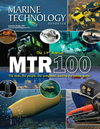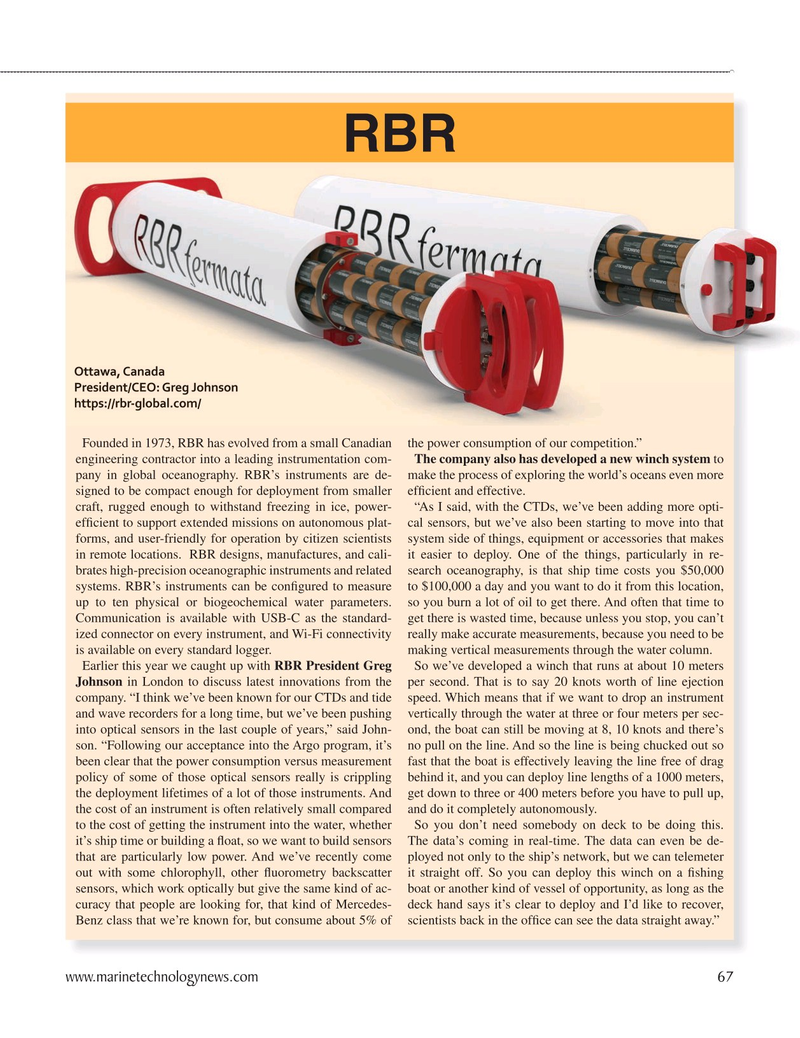
Page 67: of Marine Technology Magazine (September 2024)
Read this page in Pdf, Flash or Html5 edition of September 2024 Marine Technology Magazine
RBR
Ottawa, CanadaOttawa, Canada
President/CEO: Greg JohnsonPresident/CEO: Greg Johnson https://rbr-global.com/https://rbr-global.com/
Founded in 1973, RBR has evolved from a small Canadian the power consumption of our competition.” engineering contractor into a leading instrumentation com- The company also has developed a new winch system to pany in global oceanography. RBR’s instruments are de- make the process of exploring the world’s oceans even more signed to be compact enough for deployment from smaller ef? cient and effective.
craft, rugged enough to withstand freezing in ice, power- “As I said, with the CTDs, we’ve been adding more opti- ef? cient to support extended missions on autonomous plat- cal sensors, but we’ve also been starting to move into that forms, and user-friendly for operation by citizen scientists system side of things, equipment or accessories that makes in remote locations. RBR designs, manufactures, and cali- it easier to deploy. One of the things, particularly in re- brates high-precision oceanographic instruments and related search oceanography, is that ship time costs you $50,000 systems. RBR’s instruments can be con? gured to measure to $100,000 a day and you want to do it from this location, up to ten physical or biogeochemical water parameters. so you burn a lot of oil to get there. And often that time to
Communication is available with USB-C as the standard- get there is wasted time, because unless you stop, you can’t ized connector on every instrument, and Wi-Fi connectivity really make accurate measurements, because you need to be is available on every standard logger. making vertical measurements through the water column.
Earlier this year we caught up with RBR President Greg So we’ve developed a winch that runs at about 10 meters
Johnson in London to discuss latest innovations from the per second. That is to say 20 knots worth of line ejection company. “I think we’ve been known for our CTDs and tide speed. Which means that if we want to drop an instrument and wave recorders for a long time, but we’ve been pushing vertically through the water at three or four meters per sec- into optical sensors in the last couple of years,” said John- ond, the boat can still be moving at 8, 10 knots and there’s son. “Following our acceptance into the Argo program, it’s no pull on the line. And so the line is being chucked out so been clear that the power consumption versus measurement fast that the boat is effectively leaving the line free of drag policy of some of those optical sensors really is crippling behind it, and you can deploy line lengths of a 1000 meters, the deployment lifetimes of a lot of those instruments. And get down to three or 400 meters before you have to pull up, the cost of an instrument is often relatively small compared and do it completely autonomously.
to the cost of getting the instrument into the water, whether So you don’t need somebody on deck to be doing this. it’s ship time or building a ? oat, so we want to build sensors The data’s coming in real-time. The data can even be de- that are particularly low power. And we’ve recently come ployed not only to the ship’s network, but we can telemeter out with some chlorophyll, other ? uorometry backscatter it straight off. So you can deploy this winch on a ? shing sensors, which work optically but give the same kind of ac- boat or another kind of vessel of opportunity, as long as the curacy that people are looking for, that kind of Mercedes- deck hand says it’s clear to deploy and I’d like to recover,
Benz class that we’re known for, but consume about 5% of scientists back in the of? ce can see the data straight away.” www.marinetechnologynews.com 67
MTR #7 (66-79).indd 67 10/4/2024 3:17:12 PM

 66
66

 68
68
